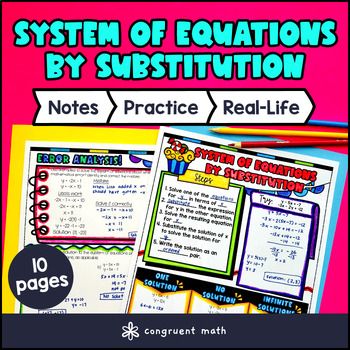Want more ideas and freebies?
Get my free resource library with digital & print activities—plus tips over email.
Join for Free Resources →
$4.25
Ever wondered how to teach system of linear equations through substitution in an engaging way to your 8th-grade students?
In this lesson plan, students will learn about solving system of equations by substitution and their real-life applications. Through artistic, interactive guided notes, check for understanding, practice coloring by code, and a maze worksheet, students will gain a comprehensive understanding of this topic.
The lesson ends with a real-life example that explores how solving simultaneous linear equations by substitution can be applied to solve practical problems in various fields.

$4.25
After this lesson, students will be able to:
Before this lesson, students should be familiar with:
As a hook, ask students why understanding how to solve systems of linear equations by substitution is important in real-life situations. Refer to the last page of the guided notes as well as the FAQs below for ideas.
Use the first page of the guided notes to introduce the concept of solving a system of two linear equations using substitution. Walk through the process of substituting one equation into the other to find the value of the variable. Identify cases where the system of linear equations by substitution will have one solution, no solution, or infinite solutions.
Repeat the instruction to teacher for each guided notes page, ensuring to cover key points such as identifying which equation to substitute, solving for one variable, and then back-substituting to find the other variable. Based on student responses, reteach concepts that students need extra help with. If your class has a wide range of proficiency levels, consider pulling out students for reteaching while having more advanced students start working on the practice exercises.
Have students practice solving system of linear equations through substitution using the maze (pg. 3 of guided notes) and color by code activity (pg. 4 of guided notes) worksheet. Walk around to answer student questions.
Fast finishers can dive into the real life application activity (pg. 5 of guided notes). You can assign any of the practice activities as homework for the remainder of the class.
Use the last page of the guided notes (pg. 5) to bring the class back together, and introduce the concept of solving a system of equations by substitution in real-life scenarios. Discuss how this mathematical skill can be used to solve problems in various fields such as economics, engineering, and science.
You can ask students to think about situations where two unknown values need to be determined simultaneously, like when calculating the cost of different items at a store, designing a structure with specific dimensions, or analyzing chemical reactions in a laboratory setting. Refer to the FAQ for more ideas on how to teach real-life applications of solving systems of equations by substitution!
If you’re looking for digital practice for adding and subtracting numbers in scientific notation, try my Pixel Art activities in Google Sheets. Every answer is automatically checked, and correct answers unlock parts of a mystery picture. It’s incredibly fun, and a powerful tool for differentiation.
Here are some activities to explore:
A fun, no-prep way to practice adding and subtracting numbers in scientific notation is Doodle Math — they’re a fresh take on color by number or color by code. It includes multiple levels levels of practice, perfect for a review day or sub plan.
Here are some activities to try:
The substitution method is a technique used to solve a system of linear equations by isolating one variable in one equation and substituting it into the other equation.
Key Points:
You should use the substitution method to solve a system of equations when one of the equations can be easily solved for one variable.
Key Points:
Solving a system of equations by substitution involves a series of steps to find the values of the variables in the system.
Key Points:
Solving systems of linear equations is important as it allows us to find the points of intersection between two lines, which are solutions to both equations simultaneously.
Key Points:
You can verify the solution obtained through the substitution method by plugging the values back into both equations to ensure they satisfy both equations simultaneously.
Key Points:
When using the substitution method, it's essential to watch out for common errors that can lead to incorrect solutions.
Key Points:
To practice solving systems of equations by substitution, you can work on various problems and exercises that involve substituting one equation into the other.
Key Points:
Yes, solving systems of linear equations by substitution has practical applications in various fields, including economics, physics, and engineering.
Key Points:
Get my free resource library with digital & print activities—plus tips over email.
Join for Free Resources →